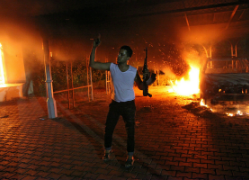
(Huffington Post)
Late at night on September 11, 2012, the American consulate in Benghazi, Libya came under fire from a violent mob. The protesters swarmed and set fire to the embassy, and American and Libyan forces did not regain control until 2:00 A.M., roughly four hours after the attackers first stormed the premises. Four Americans were killed during the attack, including the U.S. ambassador to Libya, J. Christopher Stevens. On a day already sensitive to Americans for the powerful memories of the World Trade Center, the Pentagon, and United 93, the assault on an American embassy raises questions about our foreign policy in the Middle East.
The protests outside the embassy were apparently in response to an inflammatory anti-Muslim video, which provoked similar responses in Egypt. Adding confusion to the issue, the identity of the filmmaker is unknown; the person is rumored to be either Coptic Christian or Jewish. While its maker remains a mystery, the video’s very existence emphasizes the potential dangers for a diplomat in an unstable region. American ambassadors and their staff received recommendations to leave certain countries, including Libya, soon after the offensive video appeared on YouTube. For officials whose jobs require monitoring, understanding, and improving volatile situations, there is a thin line between working in diplomacy and being thrown into aggression.
An ambassador’s responsibilities are based on trying to improve relations through diplomatic efforts. This results in an ironic foreign policy situation for ambassadors in hostile or unstable areas, such as the Middle East. The envoy must become established as a peaceful, non-threatening person who takes a genuine interest in the country. Stevens appears to have achieved that objective. During his service in Libya, he worked to promote the new democratic government and opened the U.S. Embassy in Benghazi, despite the possible dangers in a country greatly affected by civil war and continuing violence.
John Limbert, who was among the U.S. embassy staff taken hostage in Iran thirty-three years ago, raises the issue that a consul’s regard for personal safety can undermine diplomatic endeavors. Limbert notes, “You can’t just hop in your own car and drive off to a dinner somewhere. You come up with follow cars and chase cars and guys toting guns around. And then you say ‘I’m from the US government and I’m here to help?’” When working with U.S. diplomatic staff in Iraq, Limbert tried to convey a less hostile demeanor by wearing no armored clothing and having security with minimal weapons. Appearing in a less physically threatening manner can improve diplomatic work, even though security is a significant concern for diplomats.
However, U.S. foreign policy on an individual level can only prove effective with a national framework behind it. After the anti-Muslim video was posted, Stevens’ individual efforts in Libya were not enough to stop violent protests and attacks on the American embassy. There were still too many tensions due to the United States’ international image to deflect such violence. The United States needs to reconsider its foreign policy and its foreign image so that its ambassadors will better be able to balance the fine line between diplomacy and hostility.
Tanny Sevy is a 3L at the University of Denver School of Law and the Survey Editor of DJILP.


